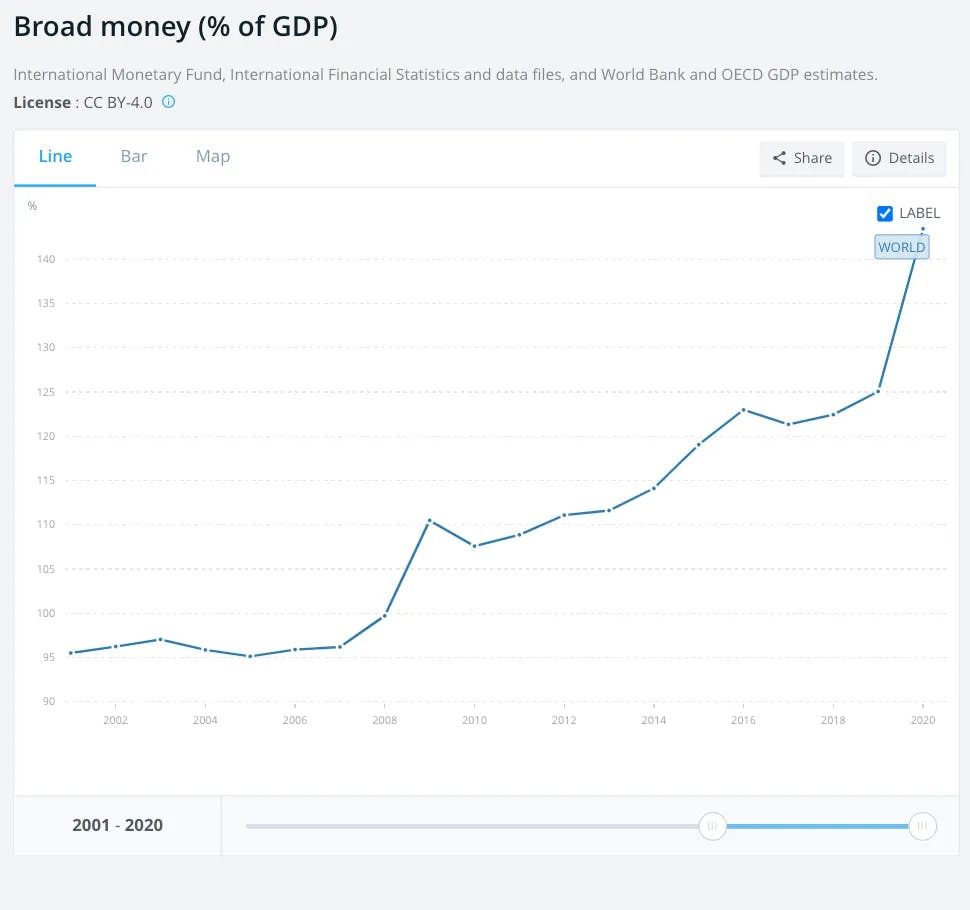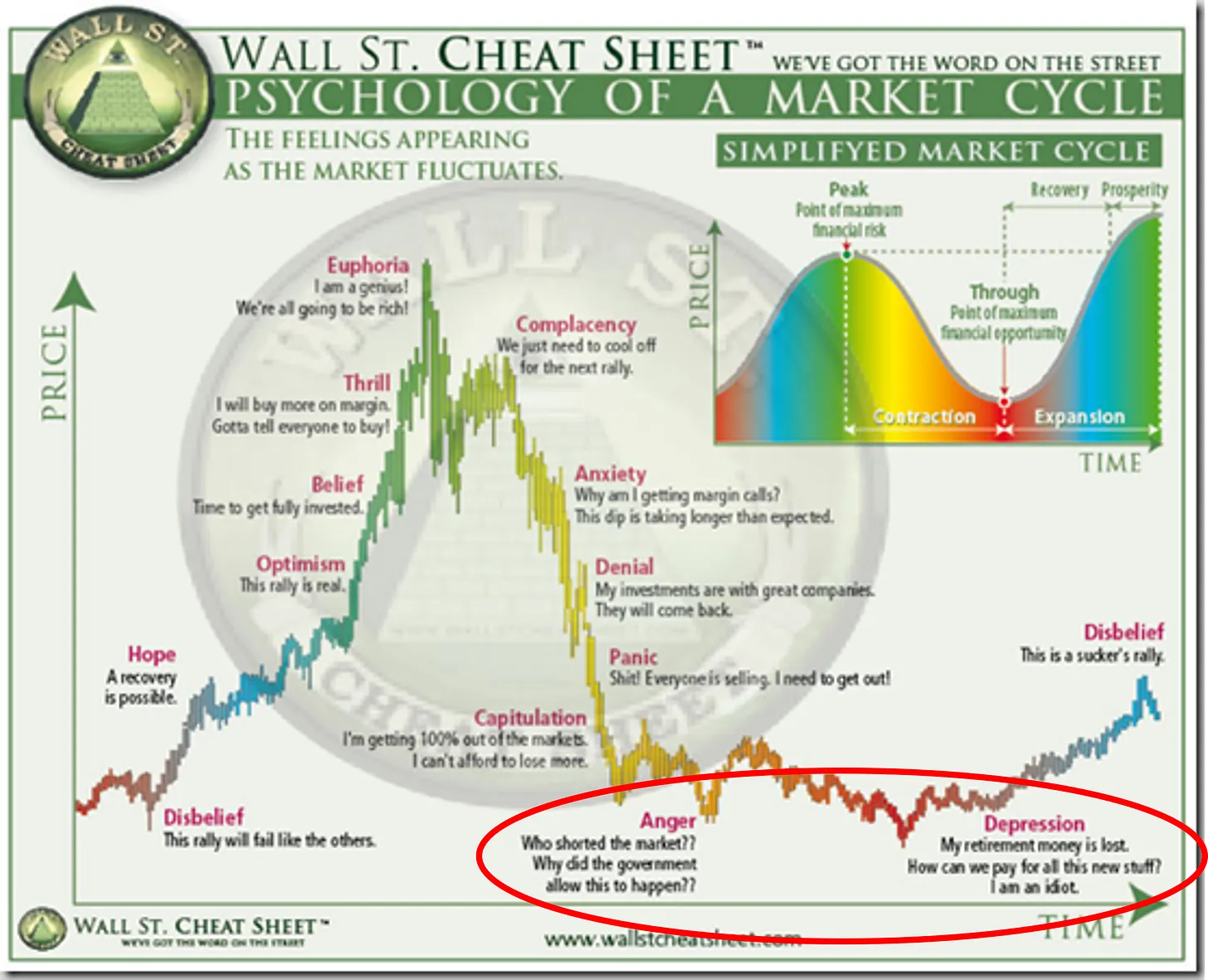On the heels of FTX’s demise, in advance of the potential collapse of USDT Tether, amidst the tightest monetary environment in a generation, staring at a looming global recession, we brace ourselves for the end of the biggest pump-and-dump in history, a rug-pull of epic proportions.
Did you think I was talking about bitcoin?
No. I’ll get to that later.
In the first two decades of the 21st Century, the world’s central banks pumped outrageous amounts of money into the financial markets. Look at the world’s supply of money from 2001 to today, as a percentage of GDP:

How’s that a pump-and-dump, you ask?
Little by little, the world’s governments bought assets, slowly building up a base, and gradually taking supply from weak hands and distressed holders. This bid up prices.
Then, in 2020, they pumped a bunch of money into the market. Prices of everything went up a lot, quickly.
As the owners of so much of the world’s assets, central banks could control the pace of selling. They let prices zoom. People FOMO’d into houses, businesses, cars, stocks, and pretty much everything they could afford.
Once enough people bought into the pump, central banks raised rates and started to dump their assets. Now they’re yanking money out of the system, rug-pulling asset holders, and leaving new buyers holding the bag.
When you do it, it’s illegal. When the government does it, it’s policy
Some might call that market manipulation, but at least they told you what they were going to do. Transparency!
If it seems like the worst is over, remember that assets like stocks, bonds, and real estate remain higher than their historical benchmarks.
In other words, even after central banks wiped possibly $50 trillion off of the world’s balance sheets, major legacy assets still have plenty of room to fall before they get back to “normal.”
Crypto, on the other hand, has already crashed. Its pump has already been dumped. Now, traders and VCs will settle whatever debts they owe each other while bad cryptos die, freeing up money and talent for good projects and healthy firms.
Can’t ignore reality
Mark, you’re nuts, crypto’s a mess, it’s all a scam, Tether will implode, $8,000 BTC incoming!
Sure, if it happens.
In May 2022, bitcoin’s on-chain and technical metrics showed the same signs as every previous market bottom. In June, we saw even more signs in the movements of bitcoins and historical measures of investor sentiment. Over the summer, those signs persisted.
This month, one of the biggest exchanges shut down. Some of the biggest trading desks collapsed. VCs and institutions lost billions of dollars.
Bitcoin’s price went down 17%.
That’s the worst monthly performance of the past year, excluding December 2021, January 2022, April 2022, and June 2022 (May 2022 went down only 16%).
That’s right, only seven of the last twelve months were better than this one.
What else happened this month?
Too much to post here and not necessary to make my point. Catch my November 14, 2022 update for more info.
Do you remember this image in the weekly rundown from October 9, 2022?

We’re somewhere in the squiggly lines in the circle. I’m not sure which side, anger or depression, but it’s one or the other.
Just wait
Mark, are you saying the bottom’s in, the worst is over, and the crypto market won’t collapse?
No. All of the circumstantial, behavioral, price action, and technical evidence matches what we see at the generational bottoms of the crypto market. That’s all.
We’ll have to wait months, possibly years before we know whether the bottom’s in (and even then some people will still call for lower prices). These patterns take a long time to appear and can last longer than you might think.
I’m more worried about other markets. They have more room to fall—and governments are seemingly hell-bent on crushing them.
What about billions in capital calls that threaten to wreak havoc on global stocks and bonds? Up to $1 trillion in CLOs and $7 trillion in junk bonds for companies that make no money? A US bond market that’s had its worst year in a generation (a century, by some estimates), and is still too high for the Fed’s liking?
Sovereign debt that doesn’t have any buyers except the taxpayers of the very countries that own the debt? Global stock markets that remain overpriced against all historical metrics? Dangerously inflated housing markets in Canada and Australia? Dangerously overleveraged households in Denmark and South Korea? Hidden liquidity problems among legacy and mainstream financial companies?
We can agree that bitcoin’s price can realistically drop to $14,000. Most altcoins will go to $0.
At the same time, you have to appreciate the circumstances and accept the reality of the situation:
Legacy assets offer less upside and more risk than ever. Bitcoin offers more upside and less risk than it has in a long time.
You just might walk away from crypto to avoid one risk and walk right into another one.
Don’t jump to conclusions
Mark, you’re saying everything else will crash and crypto will boom?
No.
Mark, you’re saying everything else will crash and crypto will crash, too?
No.
Mark, you’re saying crypto’s going up from here?
No. Stop putting words in my mouth.
Legacy markets are still waiting for the next shoe to fall. Winter is coming. China’s struggling. Europe’s also having a tough go of it. In too many places, too many people have too little food, too many problems, and not enough money.
We have many reasons for people to stay away from crypto and many reasons for people to sell their crypto.
Before you start dancing on bitcoin’s grave, take a deeper look at the world around you and the assets you consider “safe” with “intrinsic value.”
Make sure your government hasn’t lulled you into a sense of complacency, that precarious feeling that comes just before the collapse.
The world’s financial leaders have pumped the markets for years. Now they’re dumping on it. What will happen next?
And bitcoin…
Maybe it’s worth having an asset that:
-
Doesn’t derive its value from any government.
-
Can sustain itself without political violence, military coercion, government manipulation, or sovereign debt.
-
Works in all conditions even when counterparties fail.
-
Can be sent to anybody, anywhere, anytime, in any amount, without restriction, without revealing your sensitive personal information, without putting your property in another person’s control, with certainty that your transaction will go through and confirmation that every payment you receive is authentic and valid.
That’s a role that bitcoin could play.
Or not. Maybe we just need to cool off for the next rally.
I guess we’ll just have to see.
Mark Helfman publishes the Crypto is Easy newsletter. He is also the author of three books and a top bitcoin writer on Medium and Hacker Noon. Learn more about him in his bio.